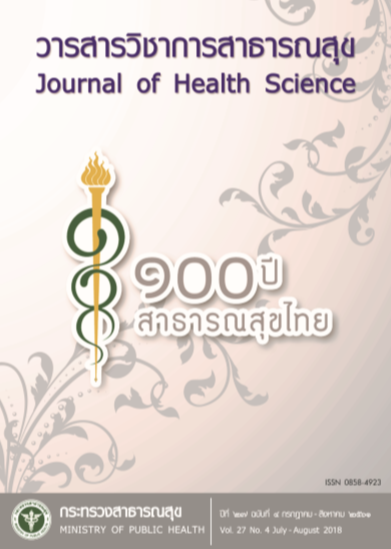Development of Continuum of Care in Takuapa Hospital Network
Keywords:
system development, continuum of care, networkingAbstract
This study aimed to develop a system and network of continuum of care using the Deming’s PDCA approach and Appreciation-Influence-Control (A-I-C) concept within the network of Takuapa hospital, Phang-Nga Province, during October 2013 – March 2016. The process included a series of activities which were divided into 5 consecutive phases including (1) situation analysis, (2) system development, (3) system implementation, (4) integrated home visits by multidisciplianry teams and local network support, and (5) coordination for continuum of care. Data were collected through interviews and observa-tion records; and were analyzed by using percentage, mean and content analysis. It was found that there were various problemsc leading to poor services for patients requring continuum of care. With the system development, database for patients sending home was organized by using Excell software. A guideline was developed for illnesses requiring continuous home care with regard to patient categorization, transfer of cases, and the use of referral and home visit data transfer by phone or Line application. Essential medical devices were managed to be borrowed by the patients for home care. Integrated home visits were organized with regular schedule and participation by multidisciplinary teams. Cases requiring social welfare support were assisted through collaboration with the local auhtorities. Community participation for continuum of care was organized through collaboration with local administration organizations, health volunteers, and religious leaders. Patient care volunteers were trained and assigned to closely manage the cases; and relatives of the patients were able to consult hospital staff when problem emerged. With the system, response rate of home visits increased from 58.84% in the year 2013 to 99.37% in 2016; and the average duration of follow-up visit after discharge from the hospital was shorten from 17.89 day in 2018 to 6.78 days in 2013. The incidence of the bed sore in in bed ridden patients infected was found to be significantly reduced, from 10.19% in 2013 to 0.95% in 2016; and time period to prepare the patients before returning home decreased from 9.75 days in 2015 to 4.27 days in 2014. As a result, all the patients and their relatives (100.00%) expressed high satisfaction toward the continuum of care system.
Downloads
Downloads
Published
How to Cite
Issue
Section
License
Copyright (c) 2018 Journal of Health Science- วารสารวิชาการสาธารณสุข

This work is licensed under a Creative Commons Attribution-NonCommercial-NoDerivatives 4.0 International License.







